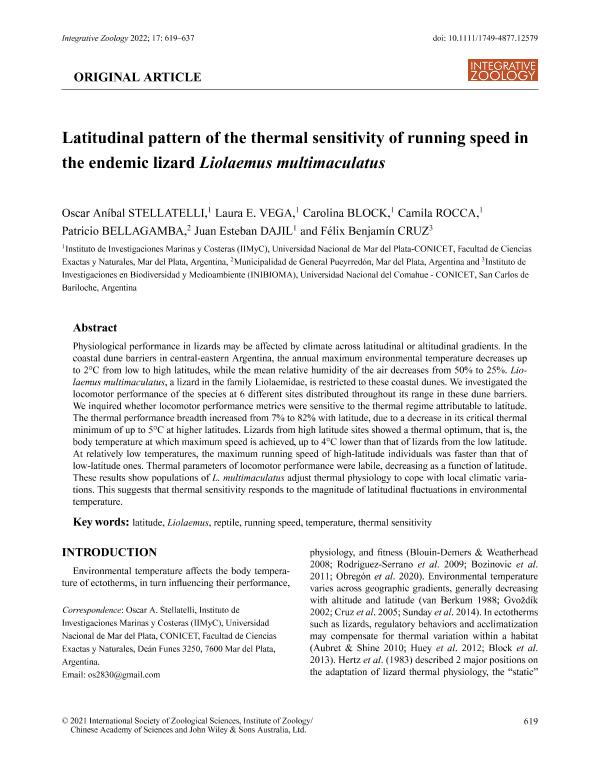Artículo
Latitudinal pattern of the thermal sensitivity of running speed in the endemic lizard Liolaemus multimaculatus
Stellatelli, Oscar Aníbal ; Vega, Laura Estela; Block, Carolina
; Vega, Laura Estela; Block, Carolina ; Rocca, Camila
; Rocca, Camila ; Bellagamba, Patricio; Dajil, Juan Esteban
; Bellagamba, Patricio; Dajil, Juan Esteban ; Cruz, Félix Benjamín
; Cruz, Félix Benjamín
 ; Vega, Laura Estela; Block, Carolina
; Vega, Laura Estela; Block, Carolina ; Rocca, Camila
; Rocca, Camila ; Bellagamba, Patricio; Dajil, Juan Esteban
; Bellagamba, Patricio; Dajil, Juan Esteban ; Cruz, Félix Benjamín
; Cruz, Félix Benjamín
Fecha de publicación:
09/2021
Editorial:
John Wiley & Sons Inc.
Revista:
Integrative Zoology
ISSN:
1749-4877
e-ISSN:
1749-4877
Idioma:
Inglés
Tipo de recurso:
Artículo publicado
Clasificación temática:
Resumen
Physiological performance in lizards may be affected by climate across latitudinal or altitudinal gradients. In the coastal dune barriers in central-eastern Argentina, the annual maximum environmental temperature decreases up to 2°C from low to high latitudes, while the mean relative humidity of the air decreases from 50% to 25%. Liolaemus multimaculatus, a lizard in the family Liolaemidae, is restricted to these coastal dunes. We investigated the locomotor performance of the species at 6 different sites distributed throughout its range in these dune barriers. We inquired whether locomotor performance metrics were sensitive to the thermal regime attributable to latitude. The thermal performance breadth increased from 7% to 82% with latitude, due to a decrease in its critical thermal minimum of up to 5°C at higher latitudes. Lizards from high latitude sites showed a thermal optimum, that is, the body temperature at which maximum speed is achieved, up to 4°C lower than that of lizards from the low latitude. At relatively low temperatures, the maximum running speed of high-latitude individuals was faster than that of low-latitude ones. Thermal parameters of locomotor performance were labile, decreasing as a function of latitude. These results show populations of L. multimaculatus adjust thermal physiology to cope with local climatic variations. This suggests that thermal sensitivity responds to the magnitude of latitudinal fluctuations in environmental temperature.
Palabras clave:
LATITUDE
,
LIOLAEMUS
,
REPTILE
,
RUNNING SPEED
,
TEMPERATURE
,
THERMAL SENSITIVITY
Archivos asociados
Licencia
Identificadores
Colecciones
Articulos(IIMYC)
Articulos de INSTITUTO DE INVESTIGACIONES MARINAS Y COSTERAS
Articulos de INSTITUTO DE INVESTIGACIONES MARINAS Y COSTERAS
Citación
Stellatelli, Oscar Aníbal; Vega, Laura Estela; Block, Carolina; Rocca, Camila; Bellagamba, Patricio; et al.; Latitudinal pattern of the thermal sensitivity of running speed in the endemic lizard Liolaemus multimaculatus; John Wiley & Sons Inc.; Integrative Zoology; 17; 4; 9-2021; 619-637
Compartir
Altmétricas



